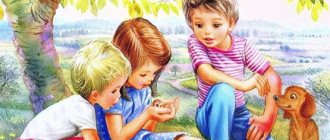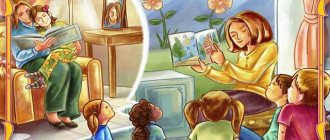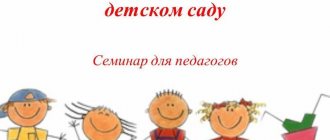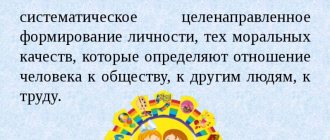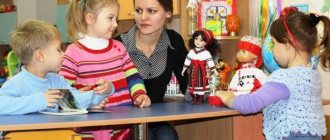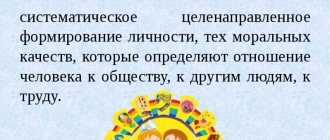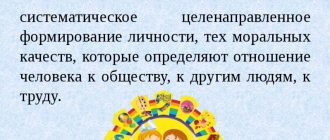Report on the topic “Spiritual and moral education of children through arts and crafts”
author: Muravyova Elena Borisovna
Teacher of additional education, MAUDO Children's and Youth Center "Rovesnik" named after Svetlana Alekseevna Krylova, Kandalaksha city, Murmansk region
Report on the topic “Spiritual and moral education of children through arts and crafts”
“Development of spiritual and moral education of children
through arts and crafts"
In the modern world, both secondary schools and additional education institutions are faced with the task of forming stable spiritual and moral qualities of a child’s personality, developing children’s creative abilities, and developing artistic and aesthetic taste.
Spiritual and moral education is the purposeful formation of moral consciousness, the development of spirituality, moral feelings and the development of skills of moral behavior. It must be focused on achieving a certain ideal. And the modern national educational ideal is a highly moral, creative, competent citizen of his country, who accepts the fate of the Fatherland as his own, aware of responsibility for the present and future of his country.
It is believed that the highest level of activity is achieved by a person in creativity. Creative activity raises a person from the level of a consumer of spiritual and material values to the level of their creator. Creativity is of great importance for the personal development of a child, starting from early childhood, and is the foundation for successful life in the future, therefore it is necessary to create optimal conditions for organizing children's creativity, creating a special educational environment so that the child can develop his own interests, realize himself, master cultural norms and values.
The additional education system provides conditions for organizing children's creativity and, consequently, for developing the creative potential of children. Here every child can find something to their liking and interest.
Decorative and applied art is one of the factors in the harmonious development of personality. Folk art, including all its types, has great educational potential. It carries a huge spiritual charge, aesthetic and moral ideals. Through communication with art, the child’s soul is enriched and a love for his region is instilled. It not only has a beneficial effect on the child’s personality, reveals his creative potential, develops his intellect, but also tells about the history of his people and their traditions.
In children's creative associations “Patchwork Mosaic”, “Do-It-Yourself Toys”, “Creative Workshop: Making Folk Dolls”, through the implementation of these programs, the spiritual and moral education of children is carried out, artistic and aesthetic taste, creative abilities, and familiarization with customs and traditions are developed. in the annual cycle of folk holidays, skills and abilities are formed for making crafts and souvenirs in the folk style, folk dolls - amulets, where each month of the year corresponds to a certain symbol doll.
Great importance is given to participation in competitions at various levels, such as: the regional stage of the All-Russian competition “Palette of Crafts”, “My Small Motherland: Nature, Culture, Ethnicity”, the All-Russian Festival “Heirs of Traditions”, etc. Project activities are being carried out aimed at more deep and detailed study and familiarization with Russian folk customs and traditions, national characteristics of the culture of the peoples of the Far North (study of life, customs, traditions, creating dolls, making costumes, ornaments in a certain color scheme), the history of the development of their small homeland. Conditions are being created to increase children's interest not only in domestic culture, in the culture and traditions of the indigenous peoples of the North (Sami and Pomors), but also in world culture and universal values.
The direct participation of children in various national holidays held in our creativity center, such as “Autumn Fun”, “Winter Christmastide”, “Maslenitsa”, “Easter”, educational quizzes “Travels around the Kola Region” and other holidays and events introduce students to with folk traditions, cultivate moral feelings, fill the child’s emotional sphere with joy, and enrich them spiritually.
Spiritual and moral education is impossible without the interested support of parents. Therefore, the institution organizes diverse interaction with parents. For example, events such as “Big Family Holiday” are held, thematic master classes and competitions are held that introduce children to family values, and parents to the culture of spending time together with their children. Such events unite children and adults with a common hobby, which not only unites them, but also forms a completely different world of interactions between children and adults.
Excursions to the museums of our city, visits to various exhibitions introduce children to the life and traditions of their region, their people, teach them a valuable attitude towards everything that man has created, help them understand the meaning and significance of the historical and spiritual value of museum objects, and form a sense of belonging to the cultural heritage. All this causes in children the desire to convey the perceived beauty of the world, to capture those objects of decorative and applied art that they liked, their creative activity awakens and develops, aesthetic feelings and artistic taste are formed, an aesthetic assessment of objects of decorative and applied art.
Students develop a variety of artistic and intellectual abilities.
The teacher’s task is not only to identify children’s creative abilities, but also to develop them by choosing an individual approach to each child. An individual approach is one of the most important conditions for a child’s creative development. Through an individual approach, support gifted and talented children, as well as children who are slightly behind.
Our children's creative associations also host various
promotions, competitions, conversations, quizzes dedicated to memorable dates, holidays, such as: Teacher's Day, Mother's Day, February 23, Victory Day, Maslenitsa, Easter, etc. In our associations, children are happy to create cards and crafts for various holidays and give them to dads, moms, grandparents, and friends.
By doing work, children learn to express themselves. They conduct a dialogue with the world, talking about their impressions and experiences in their creativity. This plays a huge role in personal development, teaching a person how to properly communicate with the outside world. Children's creative abilities when doing work develop in different directions:
- in preliminary creation of sketches on paper, cardboard, etc.;
- in thinking through the elements of composition;
- in the arrangement of these elements in the composition;
- in the creation of decorative items;
- in the ability to find a way to depict and design an object;
- in transferring the intended decorative concept to the product, etc.
For the purpose of emotional education, the creation of products is accompanied by stories, conversations, and riddles on this topic. Brief figurative characteristics help children to more clearly imagine, imagine this or that object or character, and form a friendly attitude towards it.
To achieve success in a creative team, an atmosphere of mutual understanding and mutual support is necessary, where no one is afraid to express a personal opinion, and everyone has the right to make mistakes. At the same time, a participant in the educational process must realize that any of his actions or statements affects the interests of others. Creativity arises when certain barriers (external and internal) are removed (that is, when the child is not afraid and feels comfortable) and what “rings and glows” inside a person freely, like a song, goes out into the outside world.
The need of children to express themselves in creativity is very great, its satisfaction gives them an intense feeling of the joy of life. We must protect the dreamer in every child, so that he grows up to be an active creator of scientific, industrial, cultural, and social life, a creator of his own personality.
Thus, we can conclude that arts and crafts classes are a launching pad for the formation of students’ creativity, help children realize their planned creative projects with the help of a teacher and present them in exhibitions of children’s creativity; They develop goodwill, love for their homeland, thinking, memory, imagination, artistic and aesthetic taste and creative abilities. Gradually, a small person grows into a creative, spiritually and morally developed personality, capable of creating.
Report on the topic “Spiritual and moral education of children through arts and crafts”
Master class Spiritual and moral education in literature lessons
Master Class:
“Spiritual and moral education of students in literature lessons using the example of a fragment of a lesson based on a story by V.P. Astafiev "Horse with a pink mane"
The family and secondary school are faced with the task of educating a responsible citizen, capable of independently assessing what is happening and building his activities in accordance with the interests of the people around him.
The solution to this problem is associated with the formation of stable spiritual and moral properties and personality traits of the student.
In this sense, in my opinion, literature lessons provide invaluable help, since it is here that the soul works and moral truths are discovered.
I present to your attention a master class: “Spiritual and moral education of students in literature lessons using the example of a fragment of a lesson based on a story by V.P. Astafiev “A Horse with a Pink Mane” “Life Lessons of a Hero”.
The events described in the story take place in a Siberian village in the late 20s - early 30s of the 20th century, when collective farms had just begun to be created, many still lived individually, like the hero’s grandparents, with whom he was brought up because he lost early mother.
The story of Viktor Petrovich Astafiev is autobiographical; in the hero you can recognize the author, who was born in Siberia. Childhood memories and impressions form the basis of his story “The Horse with the Pink Mane.” The main character of the story, a seven-year-old boy Vitya, encounters a lot of good and bad in his life; from his mistakes he tries to understand how he should live so as not to be tormented by remorse. Childhood is an amazing country. Her impressions last a lifetime. Man as a temple is founded in childhood. Today we must find out what life lessons underlie the development of the hero’s personality.
First of all, I ask the audience to answer the question, what do you mean by CHILDHOOD? Choose words-associations with this word. And I will ask the group to compare the audience’s associations with the protagonist’s childhood.
(audience names associations)
Our ideas about childhood practically coincided: play, laughter, happiness, pranks, carelessness, fun, joy, friendship, holidays, cartoons, walks, relaxation, candy, ice cream.
So, a question to the group: do you think the main character of the story had all this? Why?
Answer: Vitya did not have everything listed. It was a very difficult time. The first years after the civil war. The country is ruined. People live very poorly.
Yes. The story shows a difficult time. All the burdens of everyday worries fell on the shoulders of grandmother Katerina Petrovna. Pay attention to the board. Recorded statements about grandmother:
- “I’m trying to tell people about my grandmother, so that they can find her in their grandparents and loved ones, and my grandmother’s life would be limitless and eternal, just as human kindness itself is eternal.”
- “God forbid... you contradict your grandmother, do something not at her discretion.”
Who owns these words?
Answer: these are the words of a child, Vitya, and an adult, writer V.P. Astafieva.
What was most important in the grandmother’s character: severity or kindness? Or maybe both? The text will help us answer this question. In the story, the author does not give a detailed description of the grandmother’s portrait; in what ways can we imagine her image?
Answer: the image can be imagined, based on the actions and speech of the heroine.
What linguistic features distinguish grandmother?
Answer: vernacular, dialects.
Find them in the text, please.
While the group is working, I will explain that this technique helps not only to develop the ability to work with text, but also helps students understand the individuality of the hero, which the author emphasizes through speech.
So, please name the colloquial and dialect words that you found.
Answer: they are cheating, what will happen from it later, small, he did it, you will deceive your grandmother, God helped you.
In order to fully get used to the image of the characters, I invite students to feel in their place with the help of dramatizations. Let's get acquainted with the main characters of the story.
Dramatization: grandmother and grandson.
Grandmother: You'll get some tuesok. I will take my berries to the city, I will also sell yours and buy you gingerbread.
Grandson: Horse, grandma?
Grandmother: Horse, horse.
Grandson: Gingerbread horse! This is the dream of all village kids. He is white, white, this horse. And his mane is pink, his tail is pink, his eyes are pink, his hooves are also pink. You can tuck a gingerbread under your shirt, you run and hear the horse kicking its hooves into its bare belly. Cold with horror - lost - grab your shirt and with happiness make sure that he is there, the horse-fire! With such a horse, I immediately appreciate how much attention! The Levontiev guys fawn over you this way and that, and let the first one hit the siskin, and shoot with a slingshot, so that only they are then allowed to bite off the horse or lick it.
Why was horse gingerbread a desired gift for the narrator?
Answer: gingerbread is a rarity for this time, a delicacy not for everyone. And most importantly - honor, attention.
So our hero and Uncle Levontius’s boys go to the forest to buy strawberries in order to earn gingerbread with their hard work, he knows that nothing in life comes for free. However, the circumstances do not turn out at all as the hero wanted. What happened? What did the hero have to go through? To answer these questions, I propose to write down the following chain: temptation - crime - pangs of conscience - punishment - forgiveness. Let's break down the links of the chain. Everyone’s task is to find in the text a corresponding episode, an important quote to retell.
While the group is working, I would like to ask the audience, what skills are developed when performing such a task?
Audience responses: the ability to highlight the main thing, searching for information, working with information, analyzing information, constructing a coherent speech.
So, the group is ready, let's listen in order. And I ask the respected audience to trace what life lessons the hero received after living through this incident.
1st group. The main snake-tempter, neighbor Sanka, “was more harmful and evil than all the Levontiev children.” When his sisters and brothers ate all their berries, he reproached Vitya for greed and cowardice. The boy could not stand this and easily “fell for the bait” and allowed him to eat his strawberries.
2nd group. This same Sanka advised him to deceive his grandmother: “Push some herbs into the bowl, put berries on top - and you’re done!” The boy did just that. To prevent the harmful Sanka from spilling the beans, we had to steal a roll of bread for him from the pantry.
3rd group. The boy felt his guilt immediately: he couldn’t sleep for a long time, longingly awaited his grandmother’s return, thinking: “Look, how good it was to live. Walk, run, play and don’t think about anything.” In the evening he is in no hurry to go home; he goes to bed in the closet.
4th group. “And my grandmother put me to shame! And she denounced it! Only now, having fully understood into what a bottomless abyss my cheating had plunged me and what “crooked path” it would lead me to, if I had taken up the ball game so early, if I was drawn to robbery after the dashing people, I began to roar not just in repentance, but in fear that he was lost, that there was no forgiveness, no return..."
5th group. “I closed my eyes and opened my eyes. He closed his eyes again and opened them again. A white horse with a pink mane galloped across the scraped kitchen table, as if across a vast land with arable fields, meadows and roads.”
Why did the grandmother, despite the deception of her grandson, buy him gingerbread? What qualities of her were revealed in this episode?
Answer: the grandmother managed to understand and forgive her grandson.
What does it mean to understand?
Answer: to understand means to hear the experiences, thoughts of another, to share his feelings.
Let's return to the question, what was most important in the grandmother's character: severity or kindness?
Answer: kindness.
Thank you. Please tell me, dear audience, what life lessons did the hero receive?
(after the answers on the slide):
- By succumbing to the influence of others, you can commit a bad act.
- It is very difficult to admit what you have done.
- Mental remorse is very painful.
- Repentance brings relief.
- His grandmother loves him, was kind and taught him moral wisdom.
Kindness and mercy did what the heaviest punishment would not have done. Therefore: How many years have passed! How many events have passed!
And I still can’t forget my grandmother’s gingerbread -
that marvelous horse with a pink mane.
V.P. Astafiev.
Is the shape of the gingerbread “horse” random?
Answer: the choice of gingerbread is not accidental. The horse is a symbol of rural, peasant life.
At that time, a horse was a breadwinner for a peasant: it is a means of transportation, a plowman, a carrier of goods, the main character of peasant holidays, and a friend - the peasant looks after a horse like a person, communicates like a friend.
And what does the epithet “pink” bring into the name?
Answer: the color of childhood, purity, innocence.
There is an expression: “We all come from childhood.” It emphasizes that childhood is very important in the development of character. Literature lessons provide an opportunity to evaluate people's actions through artistic images and understand what is good and what is bad.
